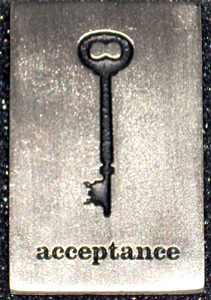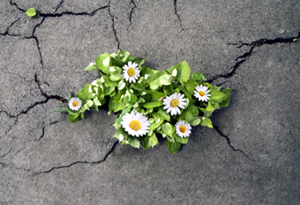Surviving Suffering and Thriving
“If suffering is accepted and lived through, not fought against and refused, then it is completed and becomes transmuted. It is absorbed, and having accomplished its work, it ceases to exist as suffering, and becomes part of our growing self.”
– Eric Graham Howe & Lilian Le Mesurier, The Open Way
Like the bumps we all get learning to walk, or learning a new sport; we all experience physical trauma. This is true emotionally as well. I work with many teens who are coping with extreme emotional trauma with a capitol “T” but we all experience those emotional bumps, scrapes—or even hammer blows—all throughout our lives. While painful, those traumas can actually help us grow positively, just like the sprained ankle in basketball practice helps us learn the right way to move on the court after we’ve healed.
 An emotional trauma is simply a crisis that was too difficult to cope with based on our existing abilities. Post-Traumatic Stress—something we all experience—is the mind, heart and body’s way of healing. Think of grieving the death of a loved one, the adjustment process in finding a new job after being fired or the self-rebuilding effort following being dumped. It’s natural. Post-Traumatic Stress Disorder occurs when, instead of being shaped by our suffering, we become stuck in that suffering. The challenge in emotional healing is defining if a difficult experience will break us down or build us up.
An emotional trauma is simply a crisis that was too difficult to cope with based on our existing abilities. Post-Traumatic Stress—something we all experience—is the mind, heart and body’s way of healing. Think of grieving the death of a loved one, the adjustment process in finding a new job after being fired or the self-rebuilding effort following being dumped. It’s natural. Post-Traumatic Stress Disorder occurs when, instead of being shaped by our suffering, we become stuck in that suffering. The challenge in emotional healing is defining if a difficult experience will break us down or build us up.
This building up in crisis is “what psychologists call posttraumatic growth (PTG), the lesser-known sibling of post-traumatic stress disorder” (Burling, 2011). The two titans in the field of Post Traumatic Growth are psychologists James Calhoun and Robert Tedeschi who first described the phenomena in 1986. “They find that individuals who struggle with life’s crises often realize positive personal growth through their loss and suffering, though no one would choose that path towards growth,” according to Major Thomas A. Jarrett, U.S. Army Social Worker. The U.S. Army has been leading the way in the study of PTG, following our recent wars, just like they did with PTSD following the Viet Nam War. Using the Post-traumatic Growth Inventory, researchers are discovering why and how many who went through similar suffering—war, cancer, loss—emerged stronger measuring their “growth or thriving responses using five categories: Appreciation of Life, Relating to Others, Personal Strength, New Possibilities and Spiritual Change” (2014).
“Depending on the trauma,” said Dr. Calhoun, “30 percent to 90 percent see improvement” in their lives. It’s a sure bet that we all desire to be in that 90 percent, and that has much to do with our perspective on the crisis itself.
Our Perception is the Prescription
“It is not the thing itself, but view men take of it that disturbs them.”
– Epictetus, Roman philosopher
Seeing the crisis as crushing loss, unsurmountable change or unacceptable injustice can lead to being stuck, while a perspective of “perceived benefit” in which a person accepts the crisis, copes, and moves  through it will help to find growth on other side (Burling, 2011). This is “part of a person’s psychological immune system…which helps convert tragedy into opportunity” and kicks into gear following a trauma with a big or little “T” (Foley, 2013).
through it will help to find growth on other side (Burling, 2011). This is “part of a person’s psychological immune system…which helps convert tragedy into opportunity” and kicks into gear following a trauma with a big or little “T” (Foley, 2013).
We all have a different emotional immune system with individual degrees of health, tolerance and impact. Thus, “post-traumatic growth,” Major Jarrett (2014) noted, “is a possibility, not a guarantee.” Dr. George Bonanno, a Columbia University psychologist who studies resilience in the bereaved, made a much less dramatic observation that “most people that go through these events, get over them…and they don’t grow either” (Burling, 2011).
We encounter suffering, some get stronger, some are weakened, and many are discomforted then walk on unchanged. The pathway of suffering is as simple and as that of the common cold, and just as old. “This is ancient,” said Dr. Tedeschi, “This is what all religion is based on: how you deal with suffering…it’s just that psychology for one reason or another didn’t want to deal with it…” still the growth following suffering is a “core aspect of human experience” that we all can benefit from learning how to improve (Burling, 2011).
“For growth to occur, crises need to be bad enough to shake one’s world, but not awful enough to shatter it” according to journalist Stacy Burling (2011) but she notes that emotional health prior to an event may be the most important factor. Researchers like Dr. Tedeschi, Calhoun and Dr. Robert Emmons, director of the Emmons Laboratory at the University of California, Davis, “arguably the nation’s leading gratitude researcher” each have studied ways to boost our psychological immune system (Foley, 2013).
Get the “You” Shot
“A good analogy is if you’re canoeing downstream and you hit a rock, it can either sink you or push you in another direction. If you choose the other direction, it’s a blessing.”
– Marshall Ramsey, Cartoonist & Cancer Survivor
 It’s flu season, the signs are up to get our shots. These shots won’t prevent the flu, but they will increase our chances of being the ones with the strongest immune system, the brief discomfort, or shortest healing time. It’s always suffering season. That’s what acceptance of suffering is; not beat-down despair at the inevitable crises of life, but head-high certainty that traumas will come and that we will face them stronger no matter the size of their “T.” If it’s always suffering season, then it’s always a good time to be inoculated, to get our “You” shot. We are our best medicine against suffering.
It’s flu season, the signs are up to get our shots. These shots won’t prevent the flu, but they will increase our chances of being the ones with the strongest immune system, the brief discomfort, or shortest healing time. It’s always suffering season. That’s what acceptance of suffering is; not beat-down despair at the inevitable crises of life, but head-high certainty that traumas will come and that we will face them stronger no matter the size of their “T.” If it’s always suffering season, then it’s always a good time to be inoculated, to get our “You” shot. We are our best medicine against suffering.
Build Acceptance: Acceptance is not blind optimism or denial. Dr. Tedeschi (2011) said. Though true optimism helps, “avoiding your problems might get you to resilience, but you’re more likely to grow if you confront them” and that confrontation isn’t “brooding about why this happened to you…but more deliberative thinking about what comes next…”Accepting the trauma happened today or yesterday is key to not allowing it to define our tomorrow.
Stay Flexible: Some encourage talking about what happened, some encourage taking quite time to contemplate first. “What really matters is not which coping behavior you use, but the flexibility to use the kind that is necessary” (Burling, 2011). Talking to a friend, pastor, minister or professional helps, as does journaling, any type of art, joining an on-line (positive) chat room or support group. Dr. Tedeschi observed that the function of a healthy psychological immune system is the core pursuit of human experience in all religions, and many share pain and finding hope in a spiritual relationship with God. The key is to not give up. If one method doesn’t do the trick—always fall back on accepting the trauma happened, but not allowing the suffering to continue.
 Live Grateful: This may be the most crucial mix in our “You Shot” crazy as it seems in the midst of our suffering. “Studies have found that gratitude is a prevailing, if counterintuitive, emotion among breast cancer survivors, people with spinal cord injuries, and post-9/11 Americans” and this is why Dr. Emmons and his colleagues are eager to help us build it. Gratitude may be the hidden growth in every trauma “…that will allow you to heal what hurts and see the victory that’s often at the center of every seeming defeat…and it may even physically alter your brain so that gratitude isn’t just something you feel occasionally but guides how you approach life.”
Live Grateful: This may be the most crucial mix in our “You Shot” crazy as it seems in the midst of our suffering. “Studies have found that gratitude is a prevailing, if counterintuitive, emotion among breast cancer survivors, people with spinal cord injuries, and post-9/11 Americans” and this is why Dr. Emmons and his colleagues are eager to help us build it. Gratitude may be the hidden growth in every trauma “…that will allow you to heal what hurts and see the victory that’s often at the center of every seeming defeat…and it may even physically alter your brain so that gratitude isn’t just something you feel occasionally but guides how you approach life.”
“If we train ourselves to look for the gifts when life is going well,” Dr. Emmons advised, “it will be easier to spot them during the rough times” because “neurons that fire together wire together.” We are advised to “have an experience of gratitude that lasts at least 20 seconds, feeling it in your body, and giving yourself over to it to help it sink into your brain” in a practice that strengthens over time. Then a crisis hits and we’re more primed to grow. When the next crisis hits and “your stress neurons fire…your gratitude neurons do so, too; and it will be easier for you to find something to be grateful for” (Foley, 2013).
We do not have a choice if we suffer. We do have a choice how we suffer and what it is ultimately worth to us. We can allow ourselves to be stuck. We can attempt to walk on unchanged or we can chose to commemorate the value of our loss in a future-focused acceptance of suffering to move forward in an ever-grateful life.
__________________________________________________
Burling, S. (2011) Studying the positive side of trauma and grief. Philadelphia Inquirer. Retrieved from: http://articles.philly.com/2011-08-15/news/29889351_1_cancers-local-researchers-psychologists
Foley, D. (2013) What It Takes To Get Through Tough Times: How a little advanced gratitude can change everything. Prevention Magazine. Retrieved from: http://www.prevention.com/mind-body/emotional-health/what-it-takes-get-through-tough-times
Jarrett, T. (2014) Post-traumatic growth–thriving through life’s crises. U.S. Army Public Health Command. Retrieved from: http://www.army.mil/article/123050/Post_traumatic_growth__thriving_through_life_s_crises/


